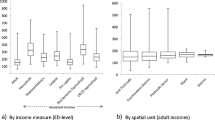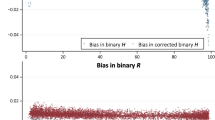Abstract
Background: Census-based methods are often used to estimate socioeconomic status. We assessed the agreement between Forward Sortation Area (FSA) and Enumeration Area (EA) derived income levels for all patients undergoing cardiac catheterization in Alberta, Canada, from 1995–1998.
Methods: Income quintiles were calculated from census data for FSA and EA level. FSAand EA-derived income measures were compared for misclassification. Both methods were then applied to the data to determine 4-year survival by income grouping in 21,446 patients following catheterization.
Results: The variability in EA-derived incomes for any given FSA-derived income is large. Only 40% of income quintiles are in agreement between the methods. For EA-based analyses, there is a linear relationship between higher income and lower mortality across all quintiles, while for FSA-based analyses, only the lowest income quintile had significantly higher mortality.
Discussion: Assuming that FSA-based methods are more likely to misclassify income compared to EA-based measures, the results for the FSA-based analyses are more likely to be erroneous. EA-derived measures should therefore be used when individual data are not available.
Résumé
Contexte: Les méthodes fondées sur le recensement sont souvent utilisées pour l’estimation du statut socio-économique. Nous avons examiné la concordance entre les revenus dérivés des régions de tri d’acheminement (RTA) et ceux dérivés des secteurs de dénombrement (SD) chez tous les patients ayant bénéficié d’un cathétérisme cardiaque en Alberta entre 1995 et 1998.
Méthodes: Nous avons comparé les mesures du revenu dérivées des RTA et des SD pour cerner d’éventuelles erreurs de classement. Ensuite, nous avons appliqué les deux méthodes aux données de 21 446 patients post-cathétérisme cardiaque afin de déterminer leur survie sur quatre ans.
Résultats: Pour toute valeur donnée des revenus dérivés des RTA, la variabilité des revenus dérivés des SD était grande, les revenus ne concordant d’une méthode à l’autre que dans 40% des cas. Ceci a des conséquences majeures dans l’analyse de l’association entre la survie et les quintiles de revenus: l’estimation de survie du quintile de revenus moyen selon les deux méthodes présente des différences significatives.
Interprétation: Les méthodes dérivées des RTA classifient mal les mesures du revenu et mènent à des résultats incorrects dans l’analyse de survie. Pour cette raison, nous proposons d’utiliser les mesures dérivées des SD si les données individuelles ne sont pas disponibles.
Similar content being viewed by others
References
Demissie K, Hanley JA, Menzies D, Joseph L, Ernst P. Agreement in measuring socio-economic status: Area-based versus individual measures. Chron Dis Can 2000;21(1):1–7.
Glazier RH, Badley EM, Gilbert JE, Rothman L. The nature of increased hospital use in poor neighbourhoods: Findings from a Canadian inner city. Can J Public Health 2000;91(4):268–73.
Jin A, Hertzman C, Peck SHS, Lockitch G. Blood lead levels in children aged 24 to 36 months in Vancouver. CMAJ 1995;152(7):1077–86.
Spasoff RA, Gilkes DT. Up-to-date denominators: Evaluation of taxation family file for public health planning. Can J Public Health 1994;85(6):413–17.
Dougherty G, Pless B, Wilkins R. Social class and the occurrence of traffic injuries and deaths in urban children. Can J Public Health 1990;81(3):204–9.
Soobader M-J, LeClere FB, Hadden W, Maury B. Using aggregate geographic data to proxy individual socioeconomic status: Does size matter? Am J Public Health 2001;91(4):632–36.
Geronimus AT, Bound J. Use of census-based aggregate variables to proxy for socioeconomic group: Evidence from national samples. Am J Epidemiol 1998;148(5):475–86.
Hankins CA, Laberge C, Lapointe N, Lai Tung MT, Racine L, O’Shaughnessy M. HIV infection among Quebec women giving birth to live infants. CMAJ 1990;143(9):885–93.
Gentleman JF, Wilkins W, Nair C, Beaulieu S. An analysis of frequencies of surgical procedures in Canada. Health Reports 1991;3(4):291–309.
Hyndman JCG, Holman CDJ, Hockey RL, Donovan RJ, Corti B, Rivera J. Misclassification of social disadvantage based on geographical areas: Comparison of postcode and collector’s district analyses. Int J Epidemiol 1995;24(1):165–76.
Krieger N. Overcoming the absence of socioeconomic data in medical records: Validation and application of a census-based methodology. Am J Public Health 1992;82(5):703–10.
Krieger N. Women and social class: A methodological study comparing individual, household, and census measures as predictors of black/white differences in reproductive history. J Epidemiol Commun Health 1991;45:35–42.
Locker D, Ford J. Using area-based measures of socioeconomic status in dental health services research. J Public Health Dentistry 1996;56(2):69–75.
Deonandan R, Campbell K, Ostbye T, Tummon I, Robertson J. A comparison of methods for measuring socio-economic status by occupation or postal area. Chron Dis Can 2000;21(3):114–18.
Mackillop WJ, Zhang-Salomons J, Groome PA. Associations between community income and cancer incidence in Canada and the United States. Cancer 2000;89(4):901–12.
Hartford K, Roos LL, Walld R. Regional variation in angiography, coronary artery bypass surgery, and percutaneous transluminal coronary angioplasty in Manitoba, 1987 to 1992: The funnel effect. Medical Care 1998;36(7):1022–32.
Jolly AM, Orr PH, Hammond G, Young TK. Risk factors for infection in women undergoing testing for chlamydia trachomatis and neisseria gonorrhoeae in Manitoba, Canada. Sexually Transmitted Dis 1995;22(5):289–95.
Anderson GM, Grumbach K, Luft HS, Roos LL. Use of coronary artery bypass surgery in the United States and Canada: Influence of age and income. JAMA 1993;269(13):1661–66.
Mackillop WJ, Zhang-Salomons J, Groome PA, Paszat L, Holowaty E. Socioeconomic status and cancer survival in Ontario. J Clin Oncol 1997;4(4):1680–89.
Boyd C, Zhang-Salomons JY, Groome PA, Mackillop WJ. Associations between community income and cancer survival in Ontario, Canada, and the United States. J Clin Oncol 1999;17(7):2244–55.
Alter DA, Naylor CD, Austin P, Tu J. Effects of socioeconomic status on access to invasive cardiac procedures and on mortality after acute myocardial infarction. N Engl J Med 1999;341(18):1359–67.
Mustard CA, Derksen S, Berthelot J-M, Wolfson M. Assessing ecologic proxies for household income: A comparison of household and neighbourhood level income measures in the study of population health status. Health and Place 1999;5:157–71.
Sin DD, Svenson LW, Paul Man SF. Do areabased markers of poverty accurately measure personal poverty? Can J Public Health 2001;92(3):184–87.
Statistics Canada. 1996 Census Dictionary–Final Edition. Ottawa. 1996; Cat 92-351-UIE.
Statistics Canada. Postal Code Conversion File, May 1999 Postal Codes (Reference Guide). Ottawa, 1999.
Ghali WA, Knudston ML, on behalf of the APPROACH Investigators. Overview of the Alberta Provincial Project for outcome assessment in coronary heart disease. Can J Cardiol 2000;16(10):1225–30.
Statistics Canada (Geography Division). Postal Code Conversion File, May 1999 version. Ottawa, 1999.
Statistics Canada. Census of Canada 1996. Alberta info [computer files].
Norris CM, Ghali WA, Knudtson ML, Naylor CD, Saunders LD. Dealing with missing data in observational health care outcome analyses. J Clin Epidemiol 2000;53:377–83.
Author information
Authors and Affiliations
Consortia
Corresponding author
Rights and permissions
About this article
Cite this article
Southern, D.A., Galbraith, P.D., Ghali, W.A. et al. Misclassification of Income Quintiles Derived from Area-based Measures. Can J Public Health 93, 465–469 (2002). https://doi.org/10.1007/BF03405041
Received:
Accepted:
Published:
Issue Date:
DOI: https://doi.org/10.1007/BF03405041




